There are projects and then there are projects that live in your dreams. Felting a large sheepskin, a fluffy felt rug, has been on my to-do list just about since I started felting. For one reason or another, I put it off. I was intimidated at the prospect of working with a raw fleece, full of vegetable matter and animals waste. But a trip to Lopez Island, where I met Maxine of Island Fibers, followed by a peek at the work of a Dutch feltmaker was just the push I needed to get started*. I bought a Rambouillet fleece in the grease, plus some shiny Border Leicester locks from Maxine.
I started with my largest piece of bubble wrap, also sold as solar pool cover, then laid down a small bamboo blind followed by a long sheet of 2mm plastic. I laid out a layer of fine merino top to create the base for my sheepskin. To keep the shingles of wool from blowing away, I sprayed down my work with soapy water every 15 seconds.
Next, I pulled out a bunch of Rambouillet locks. This must have been a very young sheep, or else a very tidy specimen because the wool was so clean the locks didn’t really hold together when I pulled them out of the bag. I was hoping to keep the locks intact, but there wasn’t enough matted wool.
Once the wool was wet and soapy, I folded the plastic over the top of the wool and then rolled up the bamboo blind, tying it together with three strips of fabric. Using my legs to roll, since I didn’t have a table set up outside, I ran out of steam pretty quickly. Two sessions of rolling for four minutes was about all I could handle. The bundle flattened out quickly and I was worried about the felt shifting inside the bundle. So, I unwrapped the package in order to work it flat for a bit.
Working it with my bare feet was the most glorious part of the process. If you don’t know the feeling of wet locks between your toes, you haven’t lived. It is better than sand, much better. The wet, soapy plastic was pretty slick; it crossed my mind that landing flat on my behind in a puddle of dirty water would be an inglorious end. It was tough to tell whether I was doing much besides washing the wool. From the color of the water puddling in the solar pool cover, it was obvious that a lot of matter was coming off the fleece.
After a few minutes of slipping and sliding, I moved inside. I rinsed the fleece gently in the laundry sink, then rolled it up in another piece of bubblewrap to work it in my rolling machine. After twenty minutes rolling slowly, I pulled it out to full it on my glass washboard. This took another thirty minutes, with lots of extra hot water and olive oil soap. I had just enough time to rinse and spin it in the washing machine before leaving to pick-up my son from school.
The resulting fleece was close to what I had imagined. I couldn’t stop fingering the locks once I made it back home. The locks are incredibly soft, impossible to resist. This is not a perfect piece, but it is a great start and I have lots of great ideas for the next iterations.
Next time, I will add another layer of merino, perpendicular to the first to give the locks a slightly thicker base. I was really hoping to get lots of long locks standing up from the fleece. Instead, I have patches of locks with patches of felt bubbles. My guess is that the long locks are from the dirtiest bits which were matted together with lanolin and dirt. The cleanest wool felted to itself, creating the flat portions. Seeing how well some of the wool felted, I will spread out the wool before I start to lay it out so I can separate the cleanest wool from the dirty locks, to create a middle layer of clean wool in between the merino wool top and the locks.
In the meantime, I have a lovely faux sheepskin to cover the cracked vinyl upholstery on the drivers’ seat of my Volvo wagon.
*In the interest of full disclosure, this is not intended as an authoritative tutorial as it was my first try working on something outside of my experience. I documented my process and examined the results to see what I could learn. I’m sharing my observations to encourage anyone else interested in trying. Inspiration and direction was gathered here and here.
*April 2011 update: after watching Tricia Stackle‘s no-roll method of felting, I’ve given up rolling my sheepskins in a blind or bubblewrap. Rub-a-dub-dub, it is all in the hands.






































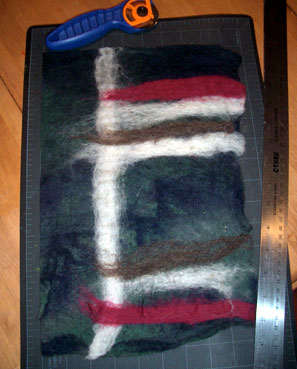
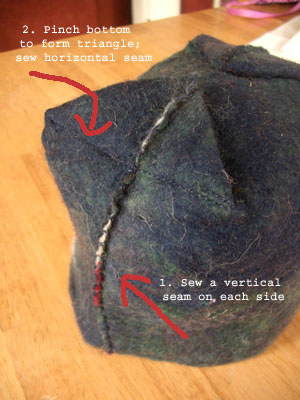
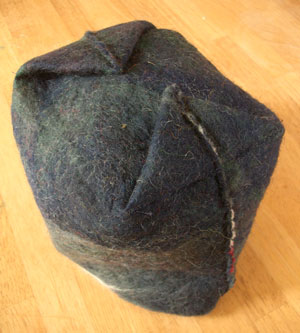
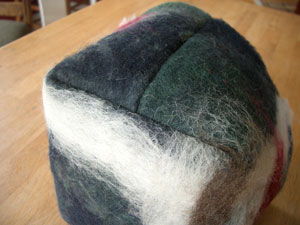
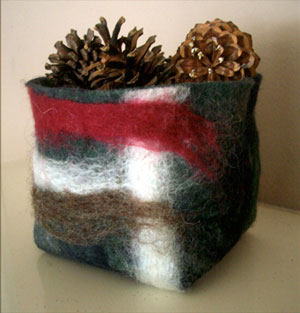
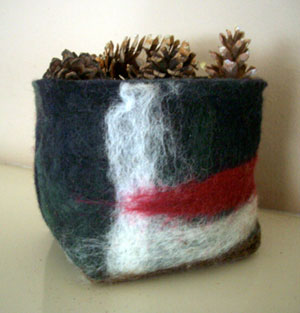











































You must be logged in to post a comment.